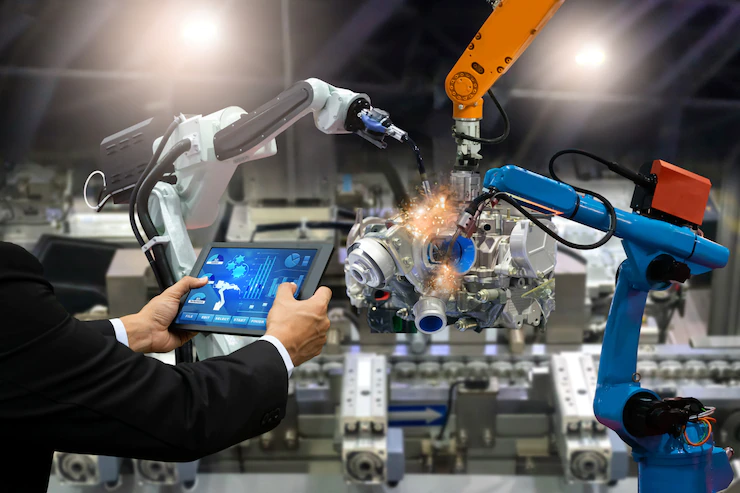Advanced Cobots For Material Handling

Table Of Contents
Material handling is the movement of products from one position to another in a manufacturing plant or factory. It includes the movement of products along a single path, particularly in processes like packaging and palletizing, as well as multiple location movements such as movement to weight and quality testing station.
Advancement in technology today has led to the development of programmable manipulators. These manipulators allow collaborative robots to execute numerous material handling processes with precise reach and an accurate payload for each task.
Types of Material Handling Collaborative Robots:

There are several types of Material Handling Cobots. Some of them include:
1. Scissor Lift Tables
These material handling collaborative robots assist workers in lifting goods and moving them from one operation station to another. Scissor tables enable workers to move equipment or stacked goods larger than the average size of humans more easily and safely compared to ladders. Scissor lift tables also lift items to much higher storage positions than manual laborers.
2. Pallet Positioners
Loading and unloading pallets can be a physically draining task that could also be potentially harmful. Automating material handling with pallet positioners allows your workers to quickly load and unload pallets.
Pallet positioners also make this process easier through their ability to rotate in any direction; hence workers do not need to stretch or bend when stacking goods on pallets.
3. Tilt Tables
Tilt Tables are variations of lift tables. They allow workers to perform tasks by positioning loads in appropriate positions for easier movement. They are a complimentary robot for other robots like palletizing, load upending, parts assembly and disassembly cobots, and roll handling cobots.
4. Automatic Dock Lifts
These are lifts that manufacturer designed to withstand rugged surfaces outdoors. They can hold over 100,000 pounds and can automatically raise or lowered to the height of any vehicle for loading or unloading.
5. Conveyor Systems
This is one of the oldest materials handling automated equipment. Conveyors are versatile machines that move products in several directions along the production line.
Some conveyor systems have built-in lifts that allow products to be raised, lowered, or transferred to any direction or angle. They are quite useful in shipping, assembly lines, loading, and unloading.
Advantages of Using New Generation Cobots for Material Handling:

Using these material handling robots in manufacturing plants benefits both workers and the business. Let us look at some advantages of using new generation robots in material handling.
1. Enhanced Features That Improve Efficiency
Today not only are human workers able to work with robots side by side, the new generation of material handling collaborative robots now. They have exoskeleton technologies that augment the workers’ physical capabilities.
These exoskeletons are made with lightweight, flexible materials that enable human workers to perform tasks faster. Not only that but this even reduces the chances of injury or strain. These exoskeletons are controlled by sophisticated software logarithms. This can sense the movement of specific body parts and respond appropriately.
Exoskeletons improve the efficiency of workers by enabling them to execute tasks with the necessary accuracy. These are within shorter time frames, which means that employees can accomplish more within shorter time frames.
2. High-Quality Delivery at a Faster Rate
Advanced collaborative robots for material handling automate physically demanding tasks that could be hazardous to human workers.
They increase production efficiencies by enhancing human capabilities to deliver goods faster in various industries. In this case it includes food and beverage, electronics, biotechnology, laboratories, automotive, and so on.
3. Reduced Cost of Production
Automation in material handling processes speeds up the rate of goods production. It has also enabled the fast movement of goods from one place to another with the assistance of very few human workers.
These advantages help business owners to reap on investment and save money that would have hired employees to execute material handling processes.
4. Space Maximization
Using human workers for material handling tasks may not only be dangerous, especially if the goods are moved to lofty positions, but it can also be cumbersome and space-consuming.
Using automated material handling systems like lifts would ease the process of material storage and free up space initially occupied by lofty ladders. Moreover, more goods can be stored on higher shelves, especially in large warehouses, allowing you to maximize storage space as much as possible.
5. Reduced Number of Work-Related Accidents
One of the biggest risks of using human workers for material handling in huge manufacturing plants is the increased likelihood of work-related accidents.
Employee safety is paramount to the business’s success as a business owner. Hence automating eliminates the need for your workers to lift heavy goods that could cause work-related accidents like falling and tripping.
6. Improved Customer Service and Customer satisfaction
Advanced material handling collaborative robots will help you increase customer satisfaction and your company’s market share.
Automation eliminates chances of error, improves shipping experiences where goods are hardly damaged, and fulfills requested orders within shorter periods. Increased customer satisfaction also attracts new customers whose orders you can meet quickly.
7. Increased Value of a Warehouse or Manufacturing Plant.
Automated systems could significantly increase the resale value of your warehouse or manufacturing plant. In case you want to sell your factory, automated material handling systems could attract more buyers, allowing you to ask for higher prices for the warehouse.
8. Attract Highly Skilled Employees
Most skilled professionals today are more attracted to companies that have adopted a certain level of automation than those that are not at all automated.
Some automated machinery does not require special training to program them, however, they need a skilled eye. Hence, attracting skilled workers could eliminate the cost of hiring specialized personnel for programming automated machinery.
Bottom Line
Although automating the material handling processes in your company will significantly increase your profit margins, it will offer many advantages to your workers as well.
It will make their work safer, easier, and less tedious, thus giving them more time to focus on things that matter most to them outside working hours. Happy workers have been proven to be more productive and innovative. So, automation is a win-win for your business on all fronts.
Read Also:
Tags:
You May Also Like

July 5, 2021
How To Close Avast Antivirus?

January 30, 2021























